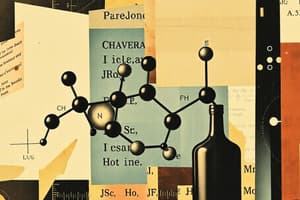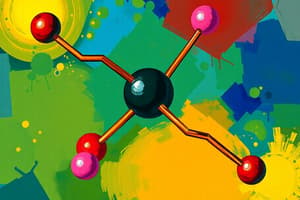Podcast
Questions and Answers
Which characteristic distinguishes benzene's reactions from those of unsaturated alkenes?
Which characteristic distinguishes benzene's reactions from those of unsaturated alkenes?
- Benzene undergoes electrophilic substitution, while alkenes undergo addition. (correct)
- Benzene undergoes addition reactions, while alkenes undergo substitution.
- Benzene reacts readily with nucleophiles, while alkenes react with electrophiles.
- Benzene requires higher temperatures for reactions compared to alkenes.
What is the significance of the delocalized π system in benzene?
What is the significance of the delocalized π system in benzene?
- It causes the benzene ring to be non-planar.
- It makes all carbon-carbon bonds identical with both single and double bond character. (correct)
- It results in alternating short and long carbon-carbon bonds.
- It prevents benzene from undergoing electrophilic attacks.
Why does benzene have a planar structure?
Why does benzene have a planar structure?
- Due to free rotation around the carbon-carbon bonds.
- Due to the sp3 hybridization of carbon atoms.
- Due to the sp2 hybridization of carbon atoms and the conjugated π system. (correct)
- Due to the presence of alternating single and triple bonds.
What type of species is directly involved in the substitution of a hydrogen atom during an electrophilic substitution reaction of benzene?
What type of species is directly involved in the substitution of a hydrogen atom during an electrophilic substitution reaction of benzene?
Which statement accurately describes the electron density distribution in benzene's π system?
Which statement accurately describes the electron density distribution in benzene's π system?
In the context of benzene reactions, what does 'in situ'refer to regarding electrophile production?
In the context of benzene reactions, what does 'in situ'refer to regarding electrophile production?
What is the approximate bond angle in benzene, and how does it relate to its structure?
What is the approximate bond angle in benzene, and how does it relate to its structure?
What is a key characteristic of electrophilic substitution reactions involving benzene?
What is a key characteristic of electrophilic substitution reactions involving benzene?
Flashcards
Aromatic Compounds
Aromatic Compounds
Molecules containing one or more benzene rings, characterized by a ring with conjugated π systems.
Conjugated π Systems
Conjugated π Systems
Arise from alternating double and single bonds in which the electrons are delocalised.
Benzene Structure
Benzene Structure
A hexagonal ring of 6 carbon atoms with alternating single and double carbon-carbon bonds.
Identical Bond Lengths
Identical Bond Lengths
Signup and view all the flashcards
Electrophilic Substitution
Electrophilic Substitution
Signup and view all the flashcards
Electrophile
Electrophile
Signup and view all the flashcards
Electron Delocalization
Electron Delocalization
Signup and view all the flashcards
sp2 Hybridization in Benzene
sp2 Hybridization in Benzene
Signup and view all the flashcards
Study Notes
- In chemistry, aromatic molecules contain one or more benzene rings, which feature a ring with conjugated π systems.
- Conjugated π systems arise from alternating double and single bonds where electrons are delocalized.
- Benzene consists of 6 carbon atoms in a hexagonal ring, with alternating single and double carbon-carbon bonds.
- Benzene and other aromatic compounds have a planar structure due to the sp2 hybridization of carbon atoms and the conjugated π system in the ring.
- Each carbon atom forms three σ bonds using the sp2 orbitals.
- Remaining p orbitals overlap laterally with p orbitals of neighboring carbon atoms to form a π system.
- Extensive sideways overlap of p orbitals results in delocalized electrons that freely spread over the entire ring.
- The π system consists of two ring-shaped clouds of electron density, one above and one below the plane.
- Benzene and other aromatic compounds are regular and planar compounds with bond angles of 120°.
- Delocalization of electrons means all carbon-carbon bonds are identical, having both single and double bond character.
- Equal bond lengths provide evidence for the delocalized ring structure of benzene.
- Benzene undergoes reactions involving the replacement of one of the six hydrogen atoms from the benzene ring.
- These reactions, where at least one H atom from benzene is replaced, are called electrophilic substitution reactions, where the hydrogen atom is substituted by the electrophile.
- Electrophilic substitution reactions involve an electrophile, which is either a positive ion or the positive end of a polar molecule.
- Numerous electrophiles can react with benzene.
- The electrophile has to be produced in situ, by adding appropriate reagents to the reaction mixture.
Studying That Suits You
Use AI to generate personalized quizzes and flashcards to suit your learning preferences.
Description
Aromatic molecules contain benzene rings with conjugated π systems, where electrons are delocalized through alternating double and single bonds. Benzene consists of six carbon atoms in a hexagonal ring with alternating single and double carbon-carbon bonds. Delocalization of electrons imparts stability and unique properties.



